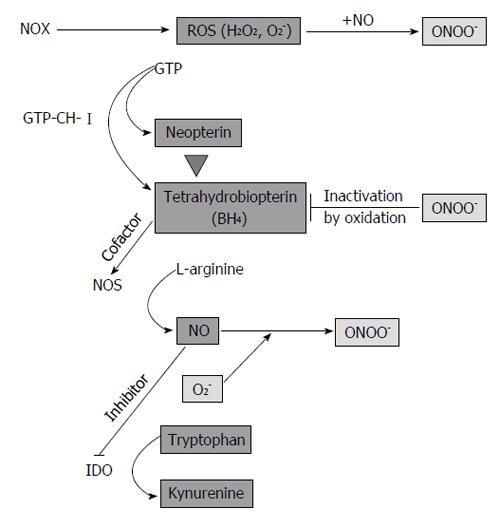Copyright
©2014 Baishideng Publishing Group Inc.
World J Cardiol. Jun 26, 2014; 6(6): 462-477
Published online Jun 26, 2014. doi: 10.4330/wjc.v6.i6.462
Published online Jun 26, 2014. doi: 10.4330/wjc.v6.i6.462
Figure 1 Regulatory circuits in inflammation and endothelial dysfunction.
During inflammation, NADPH oxidase (NOX) produces high levels of reactive oxygen species (ROS). T cells and natural killer cells produce interferon-γ, which activates enzyme GTP-cyclohydrolase I (GTP-CH-I), indoleamine 2,3-dioxygenase (IDO) and inducible nitric oxide synthase (iNOS) in monocyte-derived macrophages (M) and dendritic cells (DC). In endothelial cells, endothelial NOS (eNOS) is constitutively expressed and GTP-CH-I produces tetrahydrobioterin (BH4), which is a NOS cofactor. BH4 deficiency leads to NOS uncoupling and superoxide anion (O2-) formation, which reacts with NO to form peroxynitrite (ONOO-). In a vicious cycle, ONOO- oxidizes BH4. In M/DC, GTP-CH-I synthesizes neopterin at expense of BH4, which contributes to the low activity of iNOS in human M/DC. Furthermore, NO is a reversible inhibitor of the immunoregulatory enzyme IDO. IDO degrades the essential amino acid tryptophan to kynurenine.
- Citation: Mangge H, Becker K, Fuchs D, Gostner JM. Antioxidants, inflammation and cardiovascular disease. World J Cardiol 2014; 6(6): 462-477
- URL: https://www.wjgnet.com/1949-8462/full/v6/i6/462.htm
- DOI: https://dx.doi.org/10.4330/wjc.v6.i6.462









